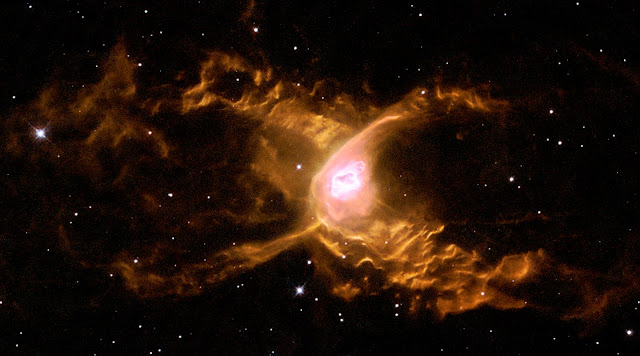Tracing Interstellar Dust Within a Galactic Pair | Webb & Hubble
Image Description: The background of this Webb and Hubble composite image of galaxy pair VV 191 is black. Two large, very bright galaxies dominate the center of the image. The elliptical galaxy at left is extremely bright at its circular core, with dimmer white light extending to its transparent circular edges. At right is a bright spiral galaxy. It also has a bright white core, but has red and light purple spiral arms that start at the center and turn clockwise going outward. They end in faint red and appear to overlap the elliptical galaxy at left. Throughout the scene are a range of distant galaxies, the majority of which are very tiny and red, appearing as splotches.
Two galaxies and two telescopes come together in this image of galaxy pair VV 191, merging Hubble’s ultraviolet and visible-light view with Webb’s infrared vision.
Webb allowed researchers to trace light emitted from the bright elliptical galaxy on the left through the spiral galaxy on the right. In doing so, astronomers were able to study the effects of interstellar dust in the spiral galaxy.
See that faint, red arc around 10 o’clock at the core of the elliptical galaxy (left)? That’s actually a distant galaxy that has been gravitationally lensed, meaning the elliptical galaxy’s gravity is so great it has stretched and magnified the background galaxy’s appearance! The distant galaxy is also duplicated as a tiny, hard-to-see dot around 4 o’clock at the center of the elliptical galaxy. Webb reveals this far-off galaxy clearly for the first time, as it was so faint that it went undetected in Hubble’s data.
By teaming up, Webb and Hubble are able to bring us an even more comprehensive view of the universe.
Note: The data here is from Webb science in progress, which has not yet been peer reviewed.
Read more: https://go.nasa.gov/3rvYKaW
Credit: NASA, European Space Agency/Canadian Space Agency, Space Telescope Science Institute (STScI), R. Windhorst (Arizona State University), W. Keel (University of Alabama), S. Wyithe (University of Melbourne, Australia), and the JWST PEARLS Team
Release Date: October 5, 2022
#NASA #ESA #Astronomy #Space #Science #Galaxies #VV191 #Spiral #Elliptical #JamesWebb #SpaceTelescopes #JWST #Hubble #Cosmos #Universe #UnfoldTheUniverse #Europe #CSA #Canada #GSFC #STScI #UnitedStates #STEM #Education







.jpg)
.png)













.jpg)